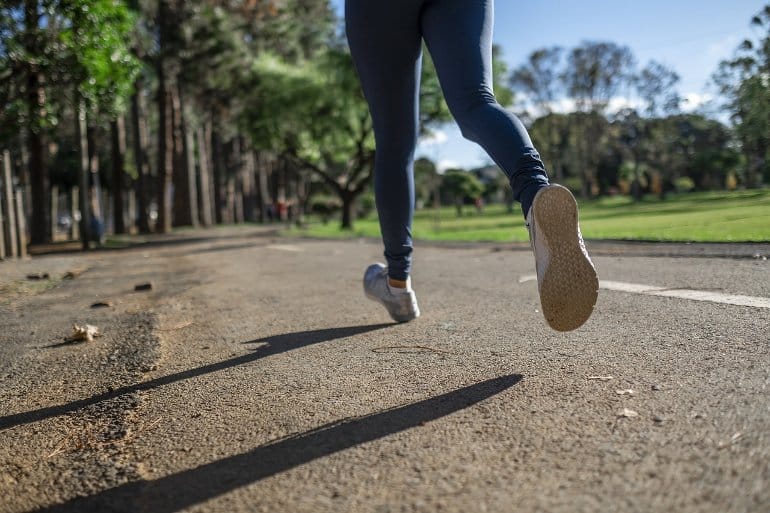Summary: Frequent moderate to vigorous exercise is linked to better cognition and brain power during middle age. This intensity level was associated with better working memory and mental processes. Reducing the intensity to lower intensity or sedentary behavior for 6-7 minutes per day was associated with poorer cognitive performance.
Source: BMJ
The amount of time spent in moderate and vigorous physical activity every day is linked to mid-life brain power, indicates research published online in the Journal of Epidemiology & Community Health.
This intensity level seems to be the best for working memory and mental processes, such as planning and organisation, and replacing it with just 6-7 minutes of light intensity activity or sedentary behaviour every day is associated with poorer cognitive performance, the findings indicate.
Previously published studies link daily moderate and vigorous physical activity, or MVPA for short, to health, but few have included time spent asleep, which makes up the largest component of any 24 hour period, say the researchers.
They therefore adopted a compositional approach to find out if MVPA relative to all other daily movement behaviours might be best for mid-life cognitive performance.
They drew on participants in the 1970 British Cohort Study, comprising people born across England, Scotland, and Wales in 1970 whose health was tracked throughout childhood and adulthood.
In 2016–18, 8581 participants had reached the ages of 46-47, at which point they were asked to fill in detailed health, background, and lifestyle questionnaires, and to wear an activity tracker for up to 7 days and for at least 10 consecutive hours a day.
They took various cognitive tests for verbal memory (immediate and delayed word recall tasks) and executive function (verbal fluency and processing speed/accuracy).
Scores for each test were summed to produce an overall global score for memory and executive function.
Among those who agreed to wear an activity tracker, 2959 participants were excluded due to device error, insufficient wear time, or failing to fully complete the questionnaires.
The final analysis included 4481 participants, just over half of whom (52%) were women. Two thirds (66%) were married and 43% were educated up to the age of 18. Over two thirds (68%) were occasional or non-risky drinkers and half had never smoked.
Analysis of the activity tracker data showed that participants clocked up an average of 51 minutes of MVPA, 5 hours 42 minutes of light intensity physical activity, 9 hours 16 minutes of sedentary behaviours, and 8 hours 11 minutes of sleep over a 24 hour period.
Time spent in MVPA relative to other types of behaviour was positively associated with cognitive performance after adjusting for educational attainment and workplace physical activity. But additional adjustment for health issues weakened these associations.
Sedentary behaviour relative to sleep and light physical intensity activity was also positively associated with cognitive performance: a trend which likely reflects greater engagement in cognitively stimulating activities such as reading or working rather than any apparent benefit from watching TV, note the researchers.
The associations were stronger for executive function than they were for memory.
Compared with the average across the sample, participants in the upper half of cognitive performance scores spent more time in MVPA and sedentary behaviours and less time sleeping, while the lowest 25% of scorers clocked up the most light intensity physical activity.
To better understand the joint associations of movement with cognition, the researchers reallocated time from one component to another, minute by minute, to estimate what impact this might have on global cognitive performance scores.
This revealed increases in scores after MVPA theoretically displaced other activities.
Individuals’ cognition showed a 1.31% improvement in cognition ranking compared to the sample average improvement after as little as 9 minutes of sedentary activities with more vigorous activities – a positive trend which became far more substantive with much greater reductions in sedentary activities.
Similarly, there was a 1.27% improvement from replacing gentle activities or 1.2% from replacing 7 minutes of sleep. Such improvements showed further improvement with greater exchanges of time.
Sedentary behaviour was also favourable for cognition score, but only after substituting it for 37 minutes of light intensity physical activity or 56 minutes of sleep.

Participants began theoretically declining in their cognition ranking within the study sample by 1-2% after just 8 minutes of more vigorous activity was replaced by sedentary activities. Ranking continued to decline with greater declines in MVPA.
Similarly, replacing vigorous activities with 6 minutes of light intensity physical activity or 7 minutes of sleep, was linked with similar falls of 1-2% in cognition ranking, again worsening for greater losses of MVPA.
The activity trackers can only capture time spent in bed rather than sleep duration or quality, which might help to explain the association with sleep, say the researchers.
“MVPA is typically the smallest proportion of the day in real terms, and the most difficult intensity to acquire. Perhaps partly for this reason, loss of any MVPA time whatsoever appeared detrimental, even within this relatively active cohort,” they explain.
This is an observational study, and as such, can’t establish cause. And the researchers highlight various caveats: activity tracker measures can’t provide context for each component of movement. And despite a large sample size, people of colour were underrepresented, limiting the generalisability of the findings.
Nevertheless, they conclude: “This robust method corroborates a critical role for MVPA in supporting cognition, and efforts should be made to bolster this component of daily movement.”
About this exercise, aging, and cognition research news
Author: Press Office
Source: BMJ
Contact: Press Office – BMJ
Image: The image is in the public domain
Original Research: Open access.
“Exploring the associations of daily movement behaviours and mid-life cognition: a compositional analysis of the 1970 British Cohort Study” by John J Mitchell et al. Journal of Epidemiology & Community Health
Abstract
Exploring the associations of daily movement behaviours and mid-life cognition: a compositional analysis of the 1970 British Cohort Study
Background
Movement behaviours (eg, sedentary behaviour (SB), moderate and vigorous physical activity (MVPA), light intensity physical activity (LIPA) and sleep) are linked to cognition, yet the relative importance of each component is unclear, and not yet explored with compositional methodologies.
Objective
To (i) assess the associations of different components of daily movement and participant’s overall cognition, memory and executive function, and (ii) understand the relative importance of each individual component for cognition.
Methods
The 1970 British Cohort Study (BCS70) is a prospective birth cohort study of UK-born adults. At age 46, participants consented to wear an accelerometer device and complete tests of verbal memory and executive function. Compositional linear regression was used to examine cross-sectional associations between 24-hour movement behaviours and standardised cognition scores. Isotemporal substitution was performed to model the effect of reallocating time between components of daily movement on cognition.
Results
The sample comprised 4481 participants (52% female). Time in MVPA relative to SB, LIPA and sleep was positively associated with cognition after adjustments for education and occupational physical activity, but additional adjustment for health status attenuated associations. SB relative to all other movements was robustly positively associated with cognition. Modelling time reallocation between components revealed an increase in cognition centile after MVPA theoretically replaced 9 min of SB (OR=1.31; 95% CI 0.09 to 2.50), 7 min of LIPA (1.27; 0.07 to 2.46) or 7 min of sleep (1.20; 0.01 to 2.39).
Conclusions
Relative to time spent in other behaviours, greater MVPA and SB was associated with higher cognitive scores. Loss of MVPA time, given its smaller relative amount, appears most deleterious. Efforts should be made to preserve MVPA time, or reinforce it in place of other behaviours.







